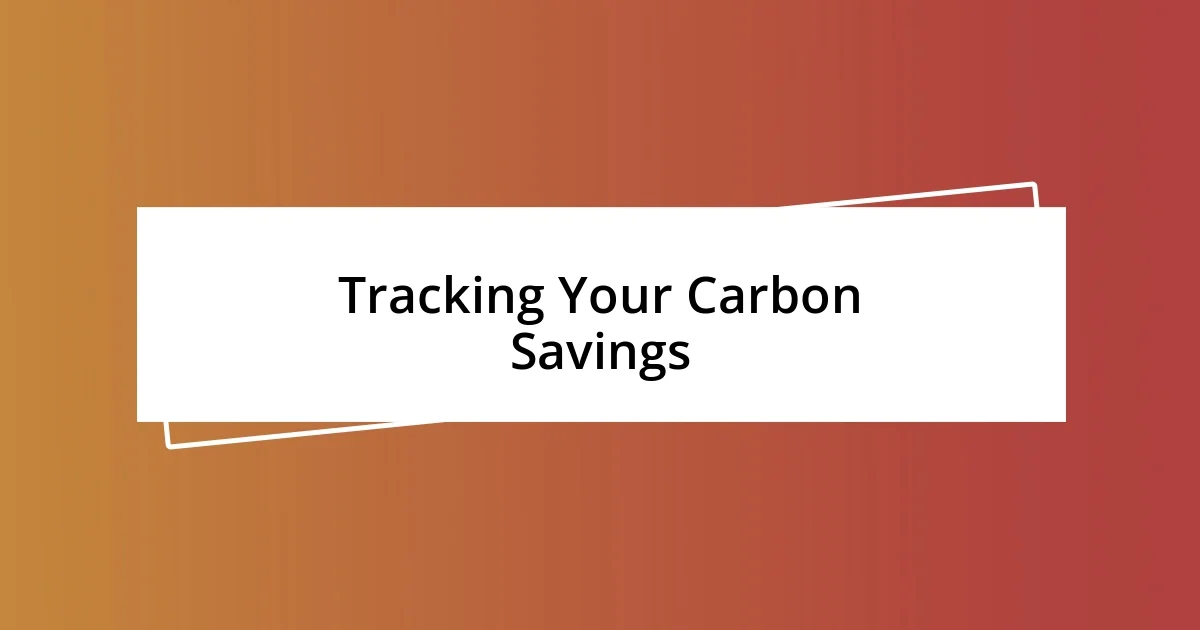Key takeaways:
- Understanding and tracking one’s carbon footprint can lead to meaningful lifestyle changes, such as reducing reliance on cars by biking.
- Biking offers significant environmental benefits, including reduced emissions, less traffic congestion, and enhanced community green spaces.
- Incorporating biking into daily routines, along with additional eco-friendly practices, fosters a deeper connection to the environment and promotes a sustainable lifestyle.

Understanding Carbon Footprint
To truly grasp the concept of a carbon footprint, it’s important to view it as the total amount of greenhouse gases emitted directly or indirectly by our actions. I remember the moment I first calculated my carbon footprint; seeing those numbers laid out made me realize the impact of my daily choices. Have you ever considered just how much simple activities contribute to your overall emissions?
Each person’s footprint varies widely based on lifestyle. For instance, I was shocked to find that my love for fast fashion added significant weight to my carbon tally. It makes me wonder: how often do we pause to assess the environmental cost of our everyday habits?
Understanding your carbon footprint can spur meaningful change. When I started biking more, I was amazed at how it not only reduced my emissions but also provided me with a sense of freedom and connection to my community. The realization that small, personal choices can ripple out to create larger change is both empowering and motivating.

Benefits of Biking for Environment
One of the most striking benefits I’ve noticed from biking is the remarkable reduction in greenhouse gas emissions. When I switched to two wheels for my daily commute, it hit me just how much cleaner the air had become around me. I could actually feel the difference on those sunny afternoons—biking felt like a refreshing way to connect with the world while doing my part for the planet.
Consider these environmental benefits of biking:
– Reduced Emissions: Every mile on a bike eliminates emissions that come from driving.
– Less Traffic Congestion: Fewer cars on the road lead to smoother traffic flow and decreased air pollution.
– Promotes Green Spaces: Communities with more cyclists tend to invest more in parks and bike paths, enhancing green spaces.
– Lower Resource Consumption: Biking reduces the reliance on fossil fuels and the demand for materials used in vehicle manufacturing.
– Wildlife Preservation: Less road traffic means fewer accidents for wildlife, allowing ecosystems to thrive.
Every time I choose my bike over my car, I cherish one less car journey—it’s a small victory, but it sends ripples of positivity into the environment. The psychological boost I receive from knowing I’m making a difference fuels my passion for biking, not just as a mode of transport but as a lifestyle choice that embodies care for our planet.

Choosing the Right Bike
Choosing the right bike is crucial for ensuring that you meet your cycling goals while also minimizing your carbon footprint. When I first considered biking more seriously, I felt overwhelmed by the plethora of choices. I realized that selecting the right bicycle isn’t just about preferences; it’s about how it aligns with your lifestyle and commuting needs. For example, a road bike is great for speed and longer distances, while a mountain bike suits rugged terrain. Have you checked the bike sizes or styles best suited for your everyday journeys?
One thing I wished I had considered more carefully was the material of the frame. Bikes made of lightweight aluminum or carbon fiber may cost more upfront but can lead to a longer lifespan and less frequent replacements. Reflecting on my early bike purchases, I realized that I was simply drawn to flashy looks rather than practicality. With the right choice, I wouldn’t have had to offset emissions with replacements so soon.
Also, think about bike features like electric assistance for longer commutes. E-bikes have redefined my biking experience, allowing me to conquer steep hills effortlessly. When discussing the options available, it’s essential to weigh the benefits versus your unique situation. Each bike offers distinct advantages that can significantly influence your carbon-saving journey.
| Type of Bike | Pros |
|---|---|
| Road Bike | Lightweight, speeds up travel, ideal for long distances |
| Mountain Bike | Durable, excellent for off-road conditions, versatile |
| Hybrid Bike | Combination of road and mountain features, comfortable for city commutes |
| E-bike | Electric assistance, easier for steep hills, great for longer rides |

Integrating Biking into Daily Life
Incorporating biking into my daily routine transformed not just my transportation but my entire lifestyle. I found myself more observant and engaged with my surroundings. For instance, cycling to work allowed me to notice the vibrant street art I’d previously overlooked while stuck in traffic. Doesn’t it feel good to appreciate those little things?
I remember those early mornings when I decided to swap my car for my bike. The fresh air as I pedaled through quiet streets was invigorating, almost like a meditation in motion. Each ride became a moment of solitude and clarity amidst the hustle of everyday life. Have you felt that sparkle of freedom when you shift gears?
Embracing biking means rethinking your daily errands too. I started using my bike for grocery runs, which encouraged me to plan better and pack lighter. I discovered that with a sturdy basket, I could carry everything I needed. What’s more, every trip felt like an adventure rather than a chore. Integrating biking into my routine reinforced my commitment to reducing my carbon footprint while enhancing my quality of life.

Tracking Your Carbon Savings
Tracking your carbon savings is an enlightening experience that can really make you appreciate your efforts. Initially, I started using apps like Strava to log my rides and see how my biking habits evolved over time. It amazed me to see the miles I covered, turning raw data into a tangible reduction in my carbon footprint. When was the last time you calculated the difference like that?
After a few months, I set up a simple spreadsheet to track both my biking distances and the carbon emissions I was preventing by not driving. Interestingly, I measured my weekly progress, watching those numbers shrink over time. It felt satisfying to see how something as simple as cycling could lead to meaningful change. The emotional high of knowing I was contributing positively to the environment was such a motivating factor—who wouldn’t feel inspired by that?
Looking back, I realized how essential it became to share these insights with friends and family. Not only did it hold me accountable, but it also created opportunities for engaging conversations around sustainability. Have you ever shared your biking achievements with someone and felt that spark of connection? It turns out that tracking my carbon savings wasn’t just a numbers game; it transformed my relationships and empowered others to reconsider their own modes of transport.

Staying Motivated for Biking
Staying motivated for biking can sometimes feel like a challenge, especially on those rainy or chilly days. I’ve learned that having a visual reminder of my goals helps tremendously. For instance, I created a biking vision board featuring images of places I want to explore and the milestones I want to achieve. When I glance at it, the excitement bubbles up, reminding me why I started this journey. Have you ever felt a surge of motivation just from visualizing your goals?
Connecting with others who share my biking passion has also kept my enthusiasm alive. I often join local biking groups, where the energy is infectious. Listening to their stories and sharing experiences creates a sense of belonging that fuels my motivation. Whether it’s discussing new trails or planning group rides, there’s something invigorating about being part of a community pushing towards the same eco-friendly goals. Have you considered reaching out to fellow cyclists in your area?
Lastly, I’ve found that setting small, achievable challenges keeps things fresh and exciting. For example, I tried to bike to work at least three times a week for a month, and the sense of accomplishment was electric. Tracking these mini-goals not only spurs me to keep going but also brings an element of fun into the routine. When you challenge yourself, don’t you feel that rush of satisfaction? It shows that staying motivated isn’t just about pushing through; it’s about making biking a joyful and engaging part of life.

Other Eco-Friendly Practices
Adopting other eco-friendly practices has truly enriched my biking experience. For example, I made it a point to carry a reusable water bottle during my rides. It’s a small change, but it cut down my plastic waste significantly. Have you ever thought about how many single-use plastic bottles we go through in a week? Just the act of refilling my bottle feels like a step toward greater sustainability.
In addition, I started composting organic waste instead of throwing it away. I’ve noticed a remarkable difference in my lifestyle. Not only does it reduce my trash output, but it creates nutrient-rich soil for my garden. After my biking sessions, I often find joy in nurturing my plants, knowing that I’m contributing less to landfills and more to a greener community. When was the last time you saw a tangible result from an eco-friendly practice in your own life?
Also, I began choosing products with minimal packaging. When I switched to bar soap instead of liquid soap in plastic bottles, it felt incredibly satisfying. It’s about making conscious choices that extend beyond biking. Each time I unwrap a new package, I feel a sense of pride knowing that I’m supporting companies that prioritize sustainability. Isn’t it empowering to realize that even our daily choices can lead to a larger positive impact on the environment?














